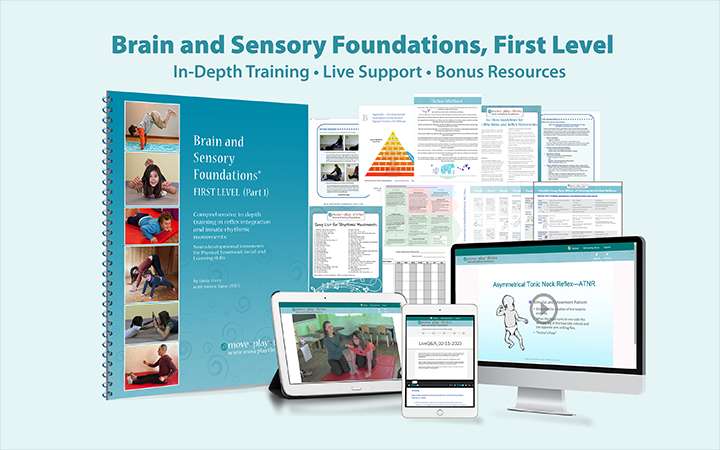Top-Rated Primitive Reflex Integration and Rhythmic Movement CEU Courses








Better Results
Less Time
More Fun
Measurable progress
you can see.
Training for Parents and Professionals
The Brain and Sensory Foundations program gives exceptional training in neurodevelopmental and integrative movements. Neurodevelopmental movements are derived from what babies do in the womb and infancy. They are largely responsible for the tremendous rate of brain growth we see in infants and toddlers. No matter what our age, these movements help mature the brain, body, and sensory systems so we can function more optimally.
Neurodevelopmental movements are calming and excellent for sensory integration. These innate movements are hardwired to develop vision, hearing, balance, core strength, postural control, muscle tone, interoception, and proprioception. Our physical, emotional, social, and learning abilities depend on these foundational movements of infancy to develop properly.
Gaps in development often stem from challenges during womb and infant life, or from trauma or injuries that occur later in life. By doing movements from the Brain and Sensory Foundations program we get a second chance to build the brain, body, and sensory systems to be the best they can be—creating more ease and effectiveness in all realms of life.
Outstanding Outcomes with Primitive Reflex Integration
- ADHD and ADD
- Anxiety, Fears, Phobias
- Autism (ASD)
- Bedwetting, Bladder, & Bowel
- Behavior Challenges
- Cerebral Palsy
- Core Strength, Posture, and Stamina
- Depression
- Developmental Delay (EI)
- Elderly Concerns
- Handwriting & Fine Motor Issues
- Hyperactivity
- Learning Challenges
- Pain
- Selective Mutism
- Sensory Processing Disorders (SPD)
- Scoliosis
- Sleep Issues
- Speech Challenges
- Toe Walking
- Trauma (PTSD)
- Vision Issues

How Can Infant Movements Help with So Many Different Challenges?
They Develop the Brain, Body, and Sensory Systems by Integrating Primitive Reflexes

Photos from Kathleen Porter, author of Healthy Posture for Babies and Children
These baby photos show how innate neurodevelopmental movements are vital for proper development. The upright, aligned babies have good core strength, stamina, mature sensory processing, and optimal brain development. They experienced a full repertoire of neurodevelopmental movements in infancy.
The slumped babies lack aligned posture and core strength; they have not fully experienced their infant neurodevelopmental movements and have less neuro-sensory-motor maturity. As they grow, the compromised babies will likely experience discomfort, fatigue, lack of focus, sensory issues, and poor learning.
Neurodevelopmental movements give babies, children, teens, and adults the best chance to develop and function well. The neurodevelopmental movements can help with many different challenges because they are innately hardwired into development to generate maturity and function in the foundational neuro-sensory-motor systems.
Our Students Say it Best
Testimonials Module
-
Nikki Kieffer, OTR/L
"Your training has transformed my practice... Every child has made so much progress...it has been so wonderful to have parents and kids excited about therapy!"
-
M. F., Parent
"This has been the only thing that has helped my highly sensitive son to be able to handle more in life around him with calm and more words to express himself than ever before.”
-
Jennifer Everett, OTR
"I have attended many courses over 25 years. This course by far has been the most beneficial."
-
Brittany Hensley, PT, DPT
"I have seen more progress in my medically fragile kids with these movements than anything else I have ever done professionally."
-
C.M., Parent
"I have done other reflex courses and this, by far, is the most practical and fun for children."
Instant Access to Outstanding Tools for Primitive Reflex Integration
A lack of neurodevelopmental movements in infancy is associated with ADHD, sensory processing disorders, anxiety, learning disorders, clumsiness, weakness, poor emotional regulation, vision disorders, poor social skills, and speech delays.
Join the Brain and Sensory Foundations® program to help transform challenges and start thriving now.
Children Love the Brain and Sensory Foundations Tools

From Erin, student of Anne Nguyen Pham
"I think rhythmic movements has (sic) helped me by staying still in my seat and paying atenchen (sic). I do it every night and it helps me get to sleep faster so I don't wake up in the middle of the night."
Erin, age 7
"The movements really helped me get through the school year and helped me focus more on school and school work. I will definitely continue to do them..."
Kallie H., age 15
“I’m more comfortable. Now I don’t get annoyed by loud things. I’m a normal kid!”
Luke, age 11
“I feel smarter. Rhythmic movement helps me listen better.”
Kyle, age 7
"Normally I feel scared and stressed out when I take tests in Math and Science. But this time I did the exercises you taught me before the WASL test. I felt so much calmer, and it made me think more clearly. In previous years I had trouble with the WASL, this year I scored much higher than ever before and easily passed all my tests."
Derrick L., age 16
“. . . the [movements] made me feel better and they help calm me down . . . I can now eat more new foods because now I know I like foods I thought I didn’t like before.”
Nathan, age 11
Meet Sonia Story—Brain and Sensory Foundations Founder and Instructor










